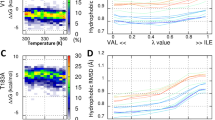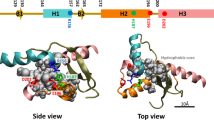Abstract
In the template-assistance model, normal prion protein (PrPC), the pathogenic cause of prion diseases such as Creutzfeldt-Jakob in human, bovine spongiform encephalopathy in cow, and scrapie in sheep, converts to infectious prion (PrPSc) through an autocatalytic process triggered by a transient interaction between PrPC and PrPSc. Conventional studies suggest the S1-H1-S2 region in PrPC to be the template of S1-S2 β-sheet in PrPSc, and the conformational conversion of PrPC into PrPSc may involve an unfolding of H1 in PrPC and its refolding into the β-sheet in PrPSc. Here we conduct a series of simulation experiments to test the idea of transient interaction of the template-assistance model. We find that the integrity of H1 in PrPC is vulnerable to a transient interaction that alters the native dihedral angles at residue Asn143, which connects the S1 flank to H1, but not to interactions that alter the internal structure of the S1 flank, nor to those that alter the relative orientation between H1 and the S2 flank.











Similar content being viewed by others
References
Aguzzi A, Sigurdson C, Heikenwaelder M (2008a) Molecular mechanisms of prion pathogenesis. Annu Rev Pathol 3:11–40
Aguzzi A, Baumann F, Bremer J (2008b) The prion’s elusive reason for being. Annu Rev Neurosci 31:439–477
Barducci A, Chelli R, Procacci P, Schettino V, Gervasio FL, Parrinello M (2006) Metadynamics simulation of prion protein: β-structure stability and the early stages of misfolding. J Am Chem Soc 128:2705–2710
Berendsen HJC, van der Spoel D, van Drunen R (1995) GROMACS: a message-passing parallel molecular dynamics implementation. Comput Phys Commun 91:43–56
Calzolai L, Zahn R (2003) Influence of pH on NMR structure and stability of the human prion protein blobular domain. J Biol Chem 278:35592–35596
Case DA, Cheatham TE, Darden T, Gohlke H, Luo R, Merz KM Jr, Onufriev A, Simmerling S, Wang B, Woods R (2005) The AMBER biomolecular simulation programs. J Comput Chem 26:1668–1688
Castilla J, Saá P, Hetz C, Soto C (2006) In vitro generation of infectious scrapie prions. Cell 121:195–206
DeLano WL (2002) PyMOL molecular graphics system. DeLano Scientific, San Carlos. http://www.pymol.org
DeMarco ML, Daggett V (2004) From conversion to aggregation: protofibril formation of the prion protein. Proc Natl Acad Sci USA 101:2293–2298
DeMarco ML, Daggett V (2007) Molecular mechanism for low pH triggered misfolding of the human prion protein. Biochem 46:3045–3054
Derreumaux P (2001) Evidence that the 127–164 region of prion proteins has two equi-energetics conformations with β or α features. Biophys J 81:1657–1665
Dima RI, Thirumalai D (2004) Probing the instabilities in the dynamics of helical fragments from mouse PrPC. Proc Natl Acad Sci USA 101:15335–15340
Eghiaian F, Grosclaude J, Lesceu S, Debey P, Doublet B, Treguer E, Rezaei H, Knossow M (2004) Insight into the PrPC→PrPSc conversion from the structures of antibody-bound ovine prion scrapie-susceptibility variants. Proc Natl Acad Sci USA 101:10254–10259
Guex N, Peitsch MC (1997) SWISS-MODEL and the Swiss-PdbViewer: an environment for comparative protein modeling. Electrophoresis 18:2714–2723
Guilbert C, Ricard F, Smith JC (2000) Dynamic simulation of the mouse prion protein. Biopolymers 54:406–415
Harris DA (1999) Cellular biology of prion diseases. Clin Microbiol Rev 12:429–444
Horiuchi M, Caughey B (1999) Prion protein interconversions and the transmissible spongiform encephalopathies. Struct Fold Des 7:R231–R240
Jackson GS, Clarke AR (2000) Mammalian prion proteins. Curr Opin Struct Biol 10:69–74
Kabsch W, Sander C (1983) Dictionary of protein secondary structure: pattern recognition of hydrogen bond and geometrical features. Biopolymers 22:2577–2637
Kozin SA, Bertho G, Mazur AK, Rabesona H, Girault JP, Haertie T, Takahashi M, Debey P, Hoa GHB (2001) Sheep prion protein synthetic peptide spanning helix 1 and β- strand 2 (Residue 142–166) shows β-hairpin structure in solution. J Biol Chem 49:46364–46370
Levy Y, Becker OM (2002) Conformational polymorphism of wild-type and mutant prion proteins: energy landscape analysis. Proteins 47:458–468
Levy Y, Hanan E, Solomon B, Becker OM (2001) Helix-coil transition of PrP106-126: molecular dynamic study. Proteins 45:382–396
Lindahl E, Hess B, van der Spoel D (2001) Gromacs 3.0: a package for molecular simulation and trajectory analysis. J Mol Model 7:306–317
Malolepsza E, Boniecki M, Kolinski A, Piela L (2005) Theoretical model of prion propagation: a misfolded protein induces misfolding. Proc Natl Acad Sci USA 102:7835–7840
Megy S, Bertho G, Kozin SA, Deby P, Hoa GHB, Girault J-O (2004) Possible role of region 152–156 in the structural duality of a peptide fragment sheep prion protein. Protein Sci 13:3151–3160
Morrissey MP, Shakhnovich EI (1999) Evidence for the role of PrPC helix 1 in the hydrophilic seeding of prion aggregates. Proc Natl Acad Sci USA 96:11293–11298
Muramoto T, Scott M, Cohen FE, Prusiner SB (1996) Recombinant scrapie-like prion protein of 106 amino acids. Proc Natl Acad Sci USA 93:15457–15462
Onufriev A, Bashford D, Case DA (2000) Modification of the generalized Born model suitable for macromolecules. J Phys Chem B 104:3712–3720
Pan KM, Baldwin M, Nguyen J, Gasset M, Serban A, Groth D, Mehlhorn I, Huang Z, Fletterick RJ, Cohen FE (1993) Conversion of α-helices into β-sheets features in the formation of the scrapie prion proteins. Proc Natl Acad Sci USA 90:10962–10966
Prusiner SB (1998) Prions. Proc Natl Acad Sci USA 95:13363–13383
Riek R, Hornemann S, Wider G, Billeter M, Glockshuber R, Wuthrich K (1996) NMR structure of the mouse prion protein domain PrP. Nature 382:180–182
Ryckaert JP, Ciccotti G, Berendsen HJC (1997) Numerical integration of the cartesian equations of motion of a system with constraints: molecular dynamics of n-alkanes. J Comput Phys 23:327–341
Santini S, Derreumaux P (2004) Helix H1 of the prion protein is rather stable against enviormental perturbations: molecular dynamics of mutation and deletion variants of PrP (90–231). Cell Mol Life Sci 61:951–960
Santini S, Calude J-B, Audic S, Derreumaux P (2003) Impact of tail and mutations G131V and M129V on prion protein flexibility. Proteins 51:258–265
Sharman GJ, Kenward N, Williams HE, Landon M, Mayer RJ, Searle MS (1998) Prion protein fragments spanning helix 1 and both strands of β-sheet (residues 125–170) show evidence for predominantly helical propensity by CD and NMR. Fold Des 3:313–320
Tompa P, Tusnady GE, Simon I (2002) The role of dimerization in prion replication. Biophys J 82:1711–1718
Watzlawik J, Sokra L, Frense D, Griesinger C, Zweckstetter M, Schulz-Schaeffer WJ, Kramer ML (2006) Prion protein helix 1 promotes aggregation but is not converted into β-sheet. J Biol Chem 281:30242–30250
van der Spoel D, Lindahl E, Hess B, van Buuren AR, Apol E, Meulenhoff PJ, Tieleman DP, Sijbers ALTM, Feenstra KA, van Drunen R, Berendsen HJC (2004) Gromacs user manual version 3.2. http://www.gromacs.org
Ziegler J, Sticht H, Marx UC, Muller W, Rosch P, Schwarzinger S (2003) CD and NMR studies of prion protein (PrP) Helix 1. J Biol Chem 278:50175–50181
Zou WQ, Cashman NR (2002) Acidic pH and detergents enhance in vitro conversion of human brain PrPC to PrPSc-like form. J Biol Chem 277:43492–43947
Acknowledgments
This work is partially supported by grants 93-2811-B-008-001 and 94-2112-M-008-013 from the National Science Council, Taiwan, ROC. We are grateful to the National Center for High-performance Computing for computer time and facilities. CYT appreciates technical help from HT Chen on the extraction of simulation data.
Author information
Authors and Affiliations
Corresponding author
Rights and permissions
About this article
Cite this article
Tseng, CY., Yu, CP. & Lee, H.C. Integrity of H1 helix in prion protein revealed by molecular dynamic simulations to be especially vulnerable to changes in the relative orientation of H1 and its S1 flank. Eur Biophys J 38, 601–611 (2009). https://doi.org/10.1007/s00249-009-0414-4
Received:
Revised:
Accepted:
Published:
Issue Date:
DOI: https://doi.org/10.1007/s00249-009-0414-4




